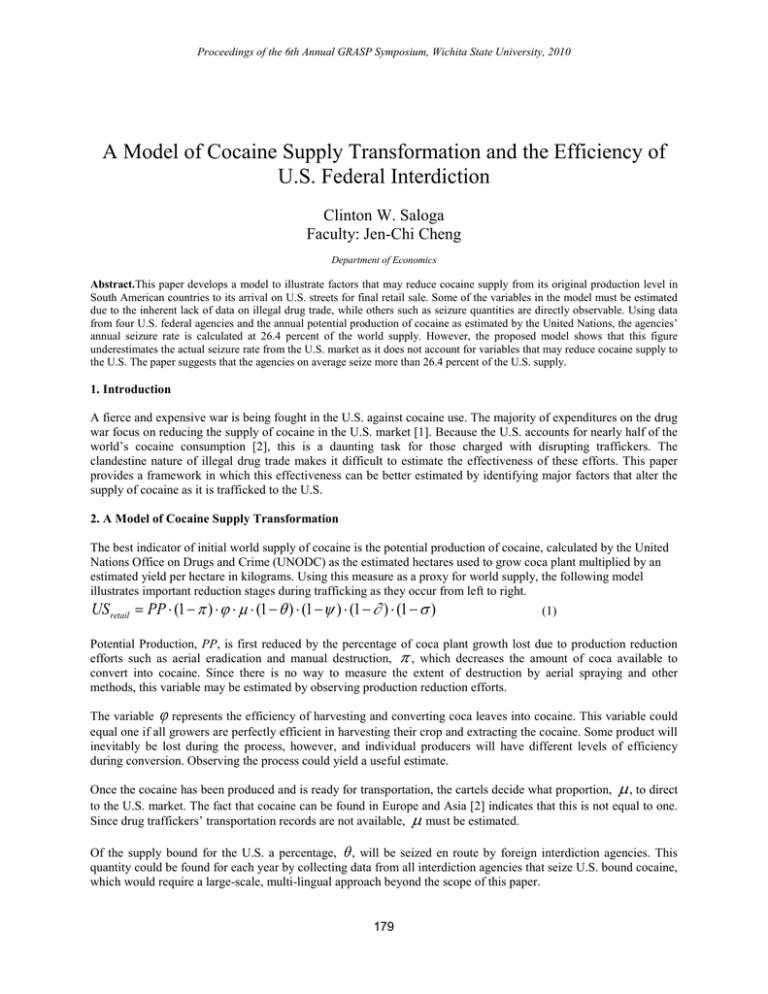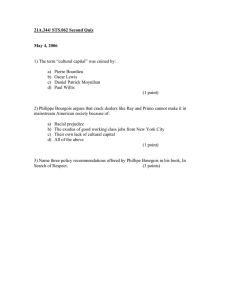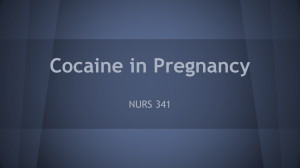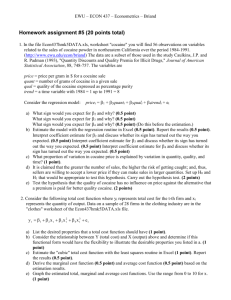A Model of Cocaine Supply Transformation and the Efficiency of
advertisement

Proceedings of the 6th Annual GRASP Symposium, Wichita State University, 2010 A Model of Cocaine Supply Transformation and the Efficiency of U.S. Federal Interdiction Clinton W. Saloga Faculty: Jen-Chi Cheng Department of Economics Abstract.This paper develops a model to illustrate factors that may reduce cocaine supply from its original production level in South American countries to its arrival on U.S. streets for final retail sale. Some of the variables in the model must be estimated due to the inherent lack of data on illegal drug trade, while others such as seizure quantities are directly observable. Using data from four U.S. federal agencies and the annual potential production of cocaine as estimated by the United Nations, the agencies’ annual seizure rate is calculated at 26.4 percent of the world supply. However, the proposed model shows that this figure underestimates the actual seizure rate from the U.S. market as it does not account for variables that may reduce cocaine supply to the U.S. The paper suggests that the agencies on average seize more than 26.4 percent of the U.S. supply. 1. Introduction A fierce and expensive war is being fought in the U.S. against cocaine use. The majority of expenditures on the drug war focus on reducing the supply of cocaine in the U.S. market [1]. Because the U.S. accounts for nearly half of the world’s cocaine consumption [2], this is a daunting task for those charged with disrupting traffickers. The clandestine nature of illegal drug trade makes it difficult to estimate the effectiveness of these efforts. This paper provides a framework in which this effectiveness can be better estimated by identifying major factors that alter the supply of cocaine as it is trafficked to the U.S. 2. A Model of Cocaine Supply Transformation The best indicator of initial world supply of cocaine is the potential production of cocaine, calculated by the United Nations Office on Drugs and Crime (UNODC) as the estimated hectares used to grow coca plant multiplied by an estimated yield per hectare in kilograms. Using this measure as a proxy for world supply, the following model illustrates important reduction stages during trafficking as they occur from left to right. US retail = PP ⋅ (1 − π ) ⋅ ϕ ⋅ µ ⋅ (1 − θ ) ⋅ (1 − ψ ) ⋅ (1 − ∂ ) ⋅ (1 − σ ) (1) Potential Production, PP, is first reduced by the percentage of coca plant growth lost due to production reduction efforts such as aerial eradication and manual destruction, π , which decreases the amount of coca available to convert into cocaine. Since there is no way to measure the extent of destruction by aerial spraying and other methods, this variable may be estimated by observing production reduction efforts. The variable ϕ represents the efficiency of harvesting and converting coca leaves into cocaine. This variable could equal one if all growers are perfectly efficient in harvesting their crop and extracting the cocaine. Some product will inevitably be lost during the process, however, and individual producers will have different levels of efficiency during conversion. Observing the process could yield a useful estimate. Once the cocaine has been produced and is ready for transportation, the cartels decide what proportion, µ , to direct to the U.S. market. The fact that cocaine can be found in Europe and Asia [2] indicates that this is not equal to one. Since drug traffickers’ transportation records are not available, µ must be estimated. Of the supply bound for the U.S. a percentage, θ , will be seized en route by foreign interdiction agencies. This quantity could be found for each year by collecting data from all interdiction agencies that seize U.S. bound cocaine, which would require a large-scale, multi-lingual approach beyond the scope of this paper. 179 Proceedings of the 6th Annual GRASP Symposium, Wichita State University, 2010 As the supply approaches the U.S. market, federal agencies such as the Drug Enforcement Administration (DEA), U.S. Coast Guard (USCG), U.S. Customs & Border Patrol (USCBP), and Immigration & Customs Enforcement (ICE) seize a proportion, ψ . Annual seizure quantities were gathered for these four agencies and averaged, then divided by the annual potential production estimates. This yielded an estimated annual average of 26.4 percent of the world supply seized by the agencies. The cocaine that escapes federal seizure then makes its way into the hands of dealers on U.S. streets. The proportion, ∂ , seized by local law enforcement agencies such as state and city police reduces this supply further. This value could be obtained in future research by collecting data from all U.S. local agencies. Finally a portion, σ , represents the quantity lost to spoilage, abandonment, disposal, or dealer consumption. These quantities are unobservable and difficult to estimate, so σ remains unknown. These variables have a significant aggregate effect in reducing the initial supply of cocaine throughout the trafficking activities en route to the U.S. consumer market. For this reason, it can be concluded that the quantity available for U.S. retail sale is considerably lower than the initial world supply. 3. The Efficiency of U.S. Federal Cocaine Interdiction U.S. officials are interested in finding the effectiveness of their federal agencies at removing cocaine from the U.S. market. In the previous section, the four agencies investigated for this paper were found to seize 26.4 percent of the world supply, proxied by the potential production estimates. Since this seizure rate is calculated as a percentage of potential production however, it understates the true effectiveness of the federal agencies in seizing cocaine from the U.S. market specifically. Looking back to equation (1), plant eradication, (1 − π ) , U.S. allocation, ( ϕ ), and international interdiction, (1 − θ ) , are all determined prior to the U.S. federal agencies’ interdiction efforts and must be accounted for. As an example, if traffickers allocate 50 percent of their product to the U.S. instead of 100 percent, thereby reducing ϕ by one half, and if all else stays constant,the 26.4 percent seizure rate of world supply would translate into 52.8 percent of the U.S. supply of imported cocaine seized among the four agencies. Further research could generate values for other variables in the models, especially international and local law enforcement interdiction ( ϕ and ∂ ), while conversion efficiency ( ϕ ) could be estimated by observing production trends, and U.S. allocation ( µ ) could be estimated by comparing U.S. seizure and usage rates to those of other countries. Defining the values or estimates of these variables could greatly improve the model’s ability to determine the true U.S. market seizure rate for both federal and local agencies. It could also give a clearer picture of the supply of cocaine available to consumers on U.S. streets. 4. Conclusion By developing a model to describe factors that alter the quantity of cocaine reaching the U.S. market, this paper sought to quantify the effectiveness of the interdiction efforts of U.S. federal agencies. The combined average seizure rate of cocaine for the four agencies investigated in this paper was calculated to be 26.4 percent of the world supply. Using this figure in conjunction with the model, the paper posits that the true seizure rate of the U.S. market supply of cocaine by the agencies is greater than 26.4 percent, due to reductions in supply that are determined prior to the cocaine arriving to the U.S. market and the subsequent U.S. federal interdiction efforts. [1] Chumacero, R. A. Evo, Pablo, Tony, Diego, and Sonny – General Equilibrium Analysis of the Illegal Drugs Market. Policy Research Working Paper 4565.The World Bank. 2008. [2] United Nations Office for Drug Control (UNODC). World Drug Reports 2004-2009. 180






